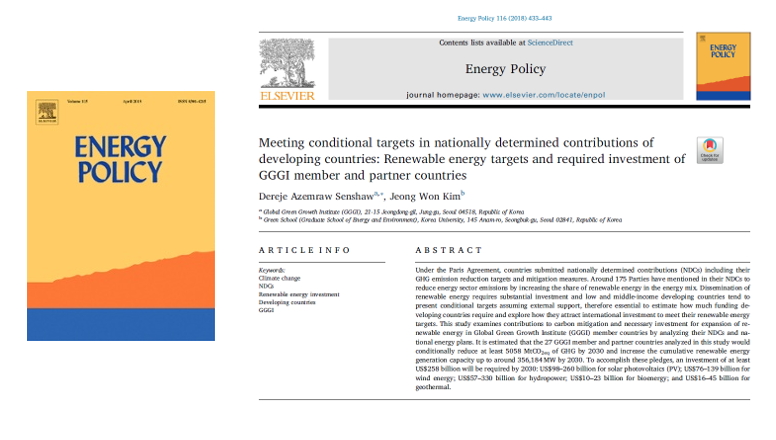New study findings by the Global Green Growth Institute (GGGI), published on March 8, 2018 in Energy Policy, an international peer reviewed journal, revealed that investment in renewables to the tune of US$258 billion will be required for 27 of its 36 Member and partner countries to significantly reduce emissions and boost renewable target achievement by 2030.
To date, 190 countries have submitted 164 Nationally Determined Contributions (NDCs) to the UNFCCC Secretariat. These plans on how each country intends to reduce emissions post-2020 cover both mitigation and adaptation. Adoption of renewable energy is one of the most popular but investment intensive mitigation measures.
Meeting conditional targets in nationally determined contributions of developing countries: Renewable energy targets and required investment of GGGI member and partner countries authors, Dereje Azemraw Senshaw , and Jeong Won Kim , write that the estimated US$258 billion would enable the 27 member and partner counties assessed to:
- Conditionally reduce at least 5058 metric tons of carbon dioxide equivalent (Mtco2Eq), of greenhouse gases in 12 years, and
- Increase the cumulative renewable energy generation capacity up to just over 356 thousand megawatts or 356 gigawatts(GW) over the same period.
They present the following investment requirement breakdown for renewables:
- US$98–260 billion for solar photovoltaics (PV)
- US$76–139 billion for wind energy
- US$57–330 billion for hydropower
- US$10–23 billion for bioenergy
- US$16–45 billion for geothermal.
The study was prompted by awareness of the substantial external investment low and middle-income countries need for renewable energy as a condition to achievement of NDC targets, and to find ways of attracting this international investment.
‘While many developing countries are willing and ready to meet the more ambitious conditional targets, many will only be able to if they can get international financial and technological assistance’, the authors write. They also point to the principles of historical responsibility and common but differentiated responsibilities enshrined in the UNFCCC, which oblige developed countries to help support climate change action by developing countries.
The Paris Agreement does not address support needed by developing countries or pledged by developed countries.
Renewable energy is a priority for developing countries not only for reducing GHG emission but also from a sustainable development perspective, including energy security and rural electrification. It also reduces vulnerability to price fluctuations associated with imported fossil fuels and improves energy security.
There have been few other studies to compare the potential costs of renewable energy investment in developing countries. Muñoz Cabré and Sokona estimated US$241 billion for unconditional renewable energy contributions with energy generation capacity of 102 gigawatts or more in the 28 African countries that pledged unconditional NDCs.
Meanwhile, Global Trends in Renewable Energy Investment 2017, published April 2017, put the total actual global expenditure on renewables at US$241.6 billion (excluding large hydro). These investments added 138.5 gigawatts to global power capacity in 2016, up 9% from the 127.5 gigawatts added the previous year.
The ideal future scenario is growth of the renewable energy market and increase in private sector investment. However, the market needs to mature further to attract private investment. Even developed countries still give subsidies to the renewable energy sector.
The 27 countries studied are GGGI members and/or partners that have conditional or combined targets in their NDCs. The study findings result from an assessment of country emissions reduction targets, renewable energy targets and the costs of renewable energy technologies.
Additional highlights
The rise in climate finance flows – up an average of 12% from 2013/14 to 2015/16, due to private investment in renewable energy sector in the China, Japan and the U.S., offers increased hope for funding support for developing countries’ renewable energy targets.
GGGI member and partner countries’ listed mitigation priorities are energy including transportation and buildings (100%), land use, land use change and forestry (LULUCF) (89%), waste management (81%), agriculture (72%) and industrial process (70%).
Solar PV is expected to account for the largest share of total renewable energy capacity at 37%. Hydropower and onshore wind energy come in second and third at 30% and 26% respectively, while bioenergy and geothermal will contribute a fraction at 4% and 3% respectively.
The top five countries in terms of investment required are: India (US$140–292 billion); Mexico (US$29–65 billion); Indonesia (US$18–53 billion); Ethiopia (US$15–92 billion); and Morocco (US$11–24 billion).
Lack of capacity, nformation, and inappropriate institutional frameworks and financing mechanisms are among the barriers to faster achievement of renewable energy targets. This includes capacity at local level, the energy planning and management levels, and the policy-making level.
GGGI and other international organizations play a key role in supporting country capacity to attract investments through enhanced legal and regulatory frameworks for renewable energy investment and training officials and local stakeholders to raise awareness of renewable energy and improve the project management.
The full report, Meeting conditional targets in nationally determined contributions of developing countries: Renewable energy targets and required investment of GGGI member and partner countries can be downloaded at: https://www.sciencedirect.com/science/article/pii/S0301421518300946
Full bibliographic details to cite the article: Energy Policy 116C (2018) pp. 433-443
